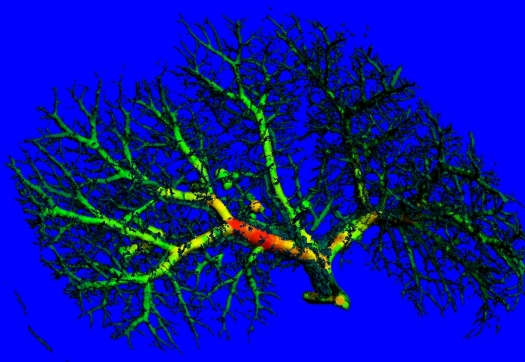Defects in hepatic Notch signaling
Sparks EE, Perrien DS, Huppert KA, Peterson TE, Huppert SS.
Department of Cell and Developmental Biology and Center for Stem Cell Biology, Vanderbilt University Medical Center, Nashville, TN 37232, USA.
Abstract
Abnormal Notch signaling in humans results in Alagille syndrome, a pleiotropic disease characterized by a paucity of intrahepatic bile ducts (IHBDs). It is not clear how IHBD paucity develops as a consequence of atypical Notch signaling, whether by a developmental lack of bile duct formation, a post-natal lack of branching and elongation or an inability to maintain formed ducts. Previous studies have focused on the role of Notch in IHBD development, and demonstrated a dosage requirement of Notch signaling for proper IHBD formation. In this study, we use resin casting and X-ray microtomography (microCT) analysis to address the role of Notch signaling in the maintenance of formed IHBDs upon chronic loss or gain of Notch function. Our data show that constitutive expression of the Notch1 intracellular domain in bi-potential hepatoblast progenitor cells (BHPCs) results in increased IHBD branches at post-natal day 60 (P60), which are maintained at P90 and P120. By contrast, loss of Notch signaling via BHPC-specific deletion of RBP-J (RBP KO), the DNA-binding partner for all Notch receptors, results in progressive loss of intact IHBD branches with age. Interestingly, in RBP KO mice, we observed a reduction in bile ducts per portal vein at P60; no further reduction had occurred at P120. Thus, bile duct structures are not lost with age; instead, we propose a model in which BHPC-specific loss of Notch signaling results in an initial developmental defect resulting in fewer bile ducts being formed, and in an acquired post-natal defect in the maintenance of intact IHBD architecture as a result of irresolvable cholestasis. Our studies reveal a previously unappreciated role for Notch signaling in the post-natal maintenance of an intact communicating IHBD structure, and suggest that liver defects observed in Alagille syndrome patients might be more complex than bile duct paucity.
